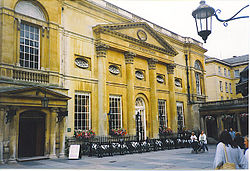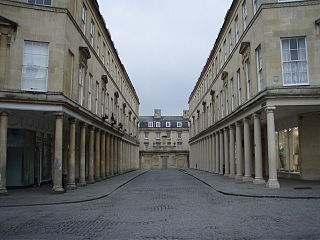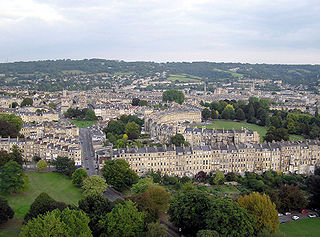History
The present building replaced an earlier one on the same site, designed by John Harvey at the request of Beau Nash, Bath's master of ceremonies, in 1706, before the discovery of Roman remains nearby. The main block, built of Bath stone, was begun by Thomas Baldwin, and the foundations of a Roman temple precinct were discovered during preparatory excavations. The North Colonnade of nine bays, with unfluted Ionic columns, was built by Baldwin in 1786–90. [6]

Beau Nash, born Richard Nash, was a celebrated dandy and leader of fashion in 18th-century Britain. He is best remembered as the Master of Ceremonies at the spa town of Bath.
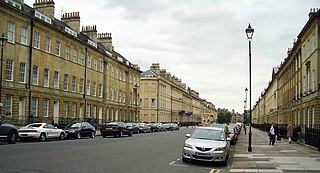
Bath Stone is an oolitic limestone comprising granular fragments of calcium carbonate. Originally obtained from the Combe Down and Bathampton Down Mines under Combe Down, Somerset, England, its warm, honey colouring gives the World Heritage City of Bath, England, its distinctive appearance. An important feature of Bath Stone is that it is a 'freestone', so-called because it can be sawn or 'squared up' in any direction, unlike other rocks such as slate, which forms distinct layers.
Thomas Baldwin was an English surveyor and architect in the city of Bath.
Baldwin was dismissed, [7] as a result of financial mismanagement in his handling of the large sums of money allocated to the purchase of raw materials such as timber and stone. Archaeological evidence reveals that he laid the foundations for a portico at the north front of the Pump Room, but this was never completed, and Baldwin was declared bankrupt in September 1793. [8] Another Bath-based architect and Baldwin's long-time rival, John Palmer, took his place as city architect and continued the scheme from 1793, altering Baldwin's design of the northern elevation, moving the location of the capitals that had been intended for the portico. [4] The building was opened by the Duchess of York on 28 December 1795 [9] and was finally finished in 1799. [1]

A portico is a porch leading to the entrance of a building, or extended as a colonnade, with a roof structure over a walkway, supported by columns or enclosed by walls. This idea was widely used in ancient Greece and has influenced many cultures, including most Western cultures.
John Palmer was an English architect who worked on some of the notable buildings in the city of Bath, Somerset, UK. He succeeded Thomas Baldwin as City Architect in 1792. He died in Bath.
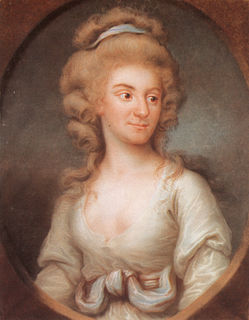
Princess Frederica Charlotte of Prussia was a Prussian and British princess. She was the eldest daughter of King Frederick William II of Prussia and the wife of Prince Frederick, Duke of York and Albany, second son of King George III of the United Kingdom.
The South Colonnade (completed 1789) [10] is similar to the North Colonnade but had an upper floor added in the late 19th century. [3] The colonnades and side wall of the Pump Room have a facade on Stall Street, with Corinthian half columns thought to have been influenced by the design of the Temple at Bassae. Willey Reveley, a contemporary expert on Greek architecture, was consulted about Palmer's revised plans. [8] However, the aspect of the building was altered by the construction in 1897 of a concert hall designed by J M Brydon. [11]

Stall Street in Bath, Somerset, England was built by John Palmer between the 1790s and the first decade of the 19th century. The buildings which form an architectural group have listed building status and are now occupied by shops and offices.

The Corinthian order is the last developed of the three principal classical orders of ancient Greek and Roman architecture. The other two are the Doric order which was the earliest, followed by the Ionic order. When classical architecture was revived during the Renaissance, two more orders were added to the canon, the Tuscan order and the Composite order. The Corinthian, with its offshoot the Composite, is the most ornate of the orders. This architectural style is characterized by slender fluted columns and elaborate capitals decorated with acanthus leaves and scrolls. There are many variations.

Bassae is an archaeological site in Oichalia, a municipality in the northeastern part of Messenia, Greece. In classical antiquity, it was part of Arcadia. Bassae lies near the village of Skliros, northeast of Figaleia, south of Andritsaina and west of Megalopolis. It is famous for the well-preserved mid- to late-5th century BC Temple of Apollo Epicurius.
The interior of the Pump Room was described in Feltham’s Guide to all the Watering and Sea-Bathing Places etc. (1813) as follows: [12]
John Feltham was an English writer, particularly for travel and antiquarian works. He is known for the Picture of London, an annual guide book that appeared from around 1800.
This noble room was built in 1797 under the direction of Mr. Baldwin, architect. It is 60 feet long by 46 wide, and 31 feet high. The inside is set round with three quarter columns of the Corinthian order, crowned with an entablature, and a covering of five feet. In a recess at the West-end is the music gallery, and in another at the East an excellent time-piece, over which is a marble statue of king Nash, executed by Hoare, at the expense of the corporation. In the Centre of the South-side is a marble vase from which issue the waters, with a fire-place on each side.
The marble vase from which visitors could drink the waters for medicinal purposes is also mentioned in Tunstall's 1860 guide to taking the waters, which also gives admission prices for the Pump Room and the adjoining King's and Queen's Baths. [13] Works by local artists William Hoare (died 1792) [14] and Thomas Gainsborough (died 1788) were also displayed there.

William Hoare of Bath was an English portraitist, painter and printmaker. From c. 1740 to 1759, he was the leading oil portraitist at Bath, Somerset, until the arrival in the town of Thomas Gainsborough. Noted for his pastels, he was a foundation member of the Royal Academy.

Thomas Gainsborough FRSA was an English portrait and landscape painter, draughtsman, and printmaker. Along with his bitter rival Sir Joshua Reynolds, he is considered one of the most important British portrait artists of the second half of the 18th century. He painted quickly, and the works of his maturity are characterised by a light palette and easy strokes. Despite being a prolific portrait painter, Gainsborough gained greater satisfaction from his landscapes. He is credited as the originator of the 18th-century British landscape school. Gainsborough was a founding member of the Royal Academy.
Original drawings by Palmer were discovered during the 1990s, which revealed how he and his predecessor Baldwin had planned the Cross Bath, which has since been restored in keeping with their intentions. The Cross Bath is now open to the public as a bathing spa, as part of the Thermae Bath Spa project. [15]
Next to the main street entrance to the Roman Baths, visitors can drink the waters from the warm spring which is the source of the baths. The building now also houses a restaurant, where afternoon tea can be taken. [16] Music in the restaurant is provided by the Pump Room Trio — the longest established resident ensemble in Europe [17] — or by a pianist. There has been music in the Pump Room since the opening of the original building in 1706, when Beau Nash put together his own band to perform there. A "Pump Room Orchestra" later came into being, with Gustav Holst being one of its guest conductors during the early 20th century. [18]
In literature
The novelist Jane Austen was familiar with the Pump Room, which is used as a setting in her novels Northanger Abbey and Persuasion . It was a meeting place for fashionable people, where "Every creature in Bath [...] was to be seen in the room at different periods of the fashionable hours". [19] It is here that Catherine Morland, the heroine of Northanger Abbey first meets Henry Tilney, another principal character in the novel. In Persuasion, Admiral Croft retires to Bath to take the waters, because of his gout. The Pump Room was used as a filming location in screen adaptations of both novels. [20]
